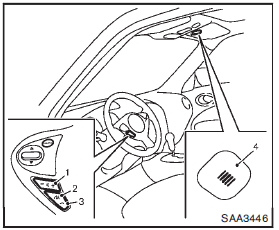Nissan Juke Owners Manual : Bluetooth® Hands-Free Phone System
WARNING
• Use a phone after stopping your vehicle in a safe location. If you have to use a phone while driving, exercise extreme caution at all times so full attention may be given to vehicle operation.
• If you find yourself unable to devote full attention to vehicle operation while talking on the phone, pull off the road to a safe location and stop your vehicle before doing so.
CAUTION
To avoid draining the vehicle battery, use a phone after starting the engine.

1. Volume control switch −/+
2. PHONE SEND  button
button
3. PHONE END  button
button
4. Microphone
Your NISSAN is equipped with the Bluetooth® Hands-Free Phone System. If you have a compatible Bluetooth® enabled cellular phone, you can set up the wireless connection between your cellular phone and the in-vehicle phone module. With Bluetooth® wireless technology, you can make or receive a hands-free telephone call in your vehicle.
Once your cellular phone is connected to the invehicle phone module, no other phone connecting procedure is required. Your phone is automatically connected with the in-vehicle phone module when the ignition switch is placed in the ON position with the connected cellular phone turned on and carried in the vehicle.
You can connect up to 5 different Bluetooth® cellular phones in the in-vehicle phone module.
However, you can talk on only one cellular phone at a time.
Before using the Bluetooth® Hands-Free Phone System, refer to the following notes.
• Wireless LAN (Wi-Fi) and the Bluetooth® functions share the same frequency band (2.4 GHz). Using the Bluetooth® and the wireless LAN functions at the same time may slow down or disconnect the communication and cause undesired noise. It is recommended that you turn off the wireless LAN (Wi-Fi) when using the Bluetooth® functions.
• Set up the wireless connection between a compatible cellular phone and the in-vehicle phone module before using the Bluetooth® Hands-Free Phone System.
• Some Bluetooth® enabled cellular phones may not be recognized by the in-vehicle phone module. Please visit www.nissanusa.
com/bluetooth for a recommended phone list and instructions for connecting your phone.
• You will not be able to use a hands-free phone under the following conditions: — Your vehicle is outside of the telephone service area.
— Your vehicle is in an area where it is difficult to receive radio waves; such as in a tunnel, in an underground parking garage, near a tall building or in a mountainous area.
— Your cellular phone is locked to prevent it from being dialed.
• When the radio wave condition is not ideal or ambient sound is too loud, it may be difficult to hear the other person’s voice during a call.
• Immediately after the ignition switch is placed in the ON position, it may be impossible to receive a call for a short period of time.
• Do not place the cellular phone in an area surrounded by metal or far away from the invehicle phone module to prevent tone quality degradation and wireless connection disruption.
• While a cellular phone is connected through the Bluetooth® wireless connection, the battery power of the cellular phone may discharge quicker than usual. The Bluetooth ® Hands-Free Phone System cannot charge cellular phones.
• If the Bluetooth® Hands-Free Phone System seems to be malfunctioning, see “Troubleshooting guide” . You can also visit www.nissanusa.com/bluetooth for troubleshooting help.
• Some cellular phones or other devices may cause interference or a buzzing noise to come from the audio system speakers.
Storing the device in a different location may reduce or eliminate the noise.
• Refer to the cellular phone Owner’s Manual regarding battery charging, cellular phone antenna, etc.
This wireless hands-free car kit is based on Bluetooth technology.
• Frequency: 2402 MHz - 2480 MHz • Output power: 4.14 dBm E.I.R.P • Modulation: FHSS GFSK 8DPSK, p/ 4DQPSK • Number of channels: 79 • This wireless equipment cannot be used for any services related to life safety because there is the possibility of radio interference.
- Regulatory information
- Using the system
- Control buttons
- Getting started
- List of voice commands
- Speaker Adaptation (SA) mode
- Troubleshooting guide
 Car phone or CB radio
Car phone or CB radio
When installing a car phone or a CB radio in your vehicle, be sure to observe
the following precautions, otherwise the new equipment may adversely affect the
electronic control modules and electro ...
 Regulatory information
Regulatory information
Bluetooth trademark:
Bluetooth® is a trademark owned by Bluetooth SIG, Inc., and licensed to Visteon
Corporation.
FCC Regulatory information
• CAUTION: To maintain compliance with FCC’s RF expo ...
Other materials:
Precaution for Supplemental Restraint System (SRS) "AIR BAG" and "SEAT BELT
PRE-TENSIONER"
The Supplemental Restraint System such as “AIR BAG” and “SEAT BELT PRE-TENSIONER”,
used along
with a front seat belt, helps to reduce the risk or severity of injury to the
driver and front passenger for certain
types of collision. Information necessary to service the system safely is
include ...
P1550 battery current sensor
DTC Logic
DTC DETECTION LOGIC
DTC CONFIRMATION PROCEDURE
1.PRECONDITIONING
If DTC Confirmation Procedure has been previously conducted, always perform
the following before conducting
the next test.
1. Turn ignition switch OFF and wait at least 10 seconds.
2. Turn ignition switch ON.
3. ...
Reverse idler shaft and gear
Exploded View
1. Reverse output gear
2. Snap ring
3. Reverse baulk ring
4. Return spring
5. Needle bearing
6. Seal washer
7. Reverse idler shaft
8. Spacer
9. Reverse input gear
10. Lock washer
11. Spring washer
: Replace the parts as a set.
: Always replace after every
disass ...
